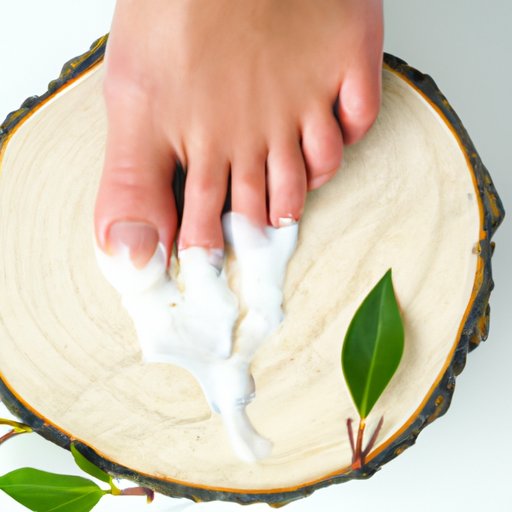
I. Introduction
Dealing with toenail fungus can be a frustrating and uncomfortable experience. There are a variety of traditional and natural remedies that may help treat this condition. In this article, we will explore the best remedies for toenail fungus and share tips on avoiding future infections.
II. Background Information
Toenail fungus, also known as onychomycosis, is a common fungal infection that affects toenails. It often begins as a white or yellow spot under the toenail and can cause the nail to become thick, brittle, and discolored over time. The fungus thrives in warm, moist environments and can be caused by exposure to damp environments, sweating, or poor hygiene practices.
III. Traditional Treatments
There are a variety of treatments available for toenail fungus. Your doctor may prescribe topical or oral medications, including antifungal creams, lotions, or pills. These treatments can be effective but can also cause side effects such as nausea, stomach pain, or skin irritation.
Topical Medications
Topical medications can be applied directly to the affected nails. It is important to follow the instructions carefully and to use them as directed for long periods of time to see results. Some common topical medications include ciclopirox and efinaconazole.
It is important to watch out for any potential side effects, including skin irritation, redness, or itching. If you experience any of these, stop using the medication and talk to your doctor.
Oral Medications
Oral medications for toenail fungus are usually prescribed for a period of several months. Some common oral medications include itraconazole and terbinafine. They work by helping the new nail grow free of infection while gradually replacing the infected part of the nail.
These medications can have side effects, including liver damage and stomach problems. It is important to follow up with your doctor and have regular blood tests while taking these medications.
IV. Home Remedies
In addition to traditional treatments, there are several home remedies that can be used to treat toenail fungus. It is important to note that these remedies may not work for everyone and should not replace traditional medical treatments.
Tea Tree Oil
Tea tree oil has antifungal properties and can be applied directly to the infected toenail. It is important to dilute the oil with a carrier oil, such as coconut oil or olive oil, to avoid skin irritation. Apply a few drops of the diluted oil to the infected toenail twice a day.
It is important to use caution when using tea tree oil, as it can cause skin irritation or allergic reactions in some people.
Apple Cider Vinegar
Apple cider vinegar has antifungal properties and can be used to help treat toenail fungus. Mix equal parts apple cider vinegar and water in a basin and soak your infected toenail in the solution for 30 minutes daily. Rinse your foot and dry it thoroughly.
Using undiluted apple cider vinegar may cause skin irritation, so it is important to dilute it before using it on your skin.
Aloe Vera
Aloe vera has antifungal properties and can be used to help treat toenail fungus. Cut open an aloe vera leaf and apply the gel to the infected toenail twice a day. Aloe vera can also help soothe any skin irritation caused by toenail fungus.
It is important to look for 100% pure aloe vera gel to avoid any potential added chemicals or fragrances that may irritate the skin.
V. Medical Treatments
There are several medical treatments available for toenail fungus. Laser therapy and photodynamic therapy are two options that may be effective in treating toenail fungus.
Laser Therapy
Laser therapy uses a laser to penetrate the toenail and kill the fungus. It is a non-invasive procedure that typically requires multiple treatments. It is important to note that laser therapy can be expensive and may not be covered by insurance.
Photodynamic Therapy
Photodynamic therapy involves a topical solution that is applied to the toenail and then activated by a special light. The solution kills the fungus while leaving healthy tissue unharmed. It is a newer treatment and may not be widely available.
VI. Lifestyle Changes
There are several lifestyle changes that can help prevent and treat toenail fungus.
Wearing Breathable Shoes and Socks
Wearing breathable shoes and socks can help prevent toenail fungus. Avoid wearing tight or uncomfortable shoes and choose socks made of breathable materials like cotton.
Keeping Feet Dry
Keeping your feet dry is important in preventing toenail fungus. Wear moisture-wicking socks and change them often. Allow your shoes to dry out completely before wearing them again.
Trimming Toenails Regularly
Trimming your toenails regularly and keeping them short can help prevent toenail fungus. Use clean nail clippers and cut straight across the nail to avoid ingrown toenails.
VII. Hygiene Practices
Maintaining proper foot hygiene can help prevent toenail fungus.
Proper Foot Hygiene
Wash your feet with soap and water regularly and dry them thoroughly, especially between the toes. Avoid walking barefoot in public places like pools or locker rooms. Wear flip flops or sandals when necessary to protect your feet.
Avoiding Sharing Personal Items
Avoid sharing personal items that come into contact with the feet, such as shoes or nail clippers. This can help prevent the spread of toenail fungus.
Keeping Shoes Dry and Clean
Keeping your shoes dry and clean can help prevent toenail fungus. Clean your shoes regularly and allow them to dry out completely before wearing them again.
VIII. Conclusion
Toenail fungus can be a frustrating and uncomfortable condition, but there are several remedies and prevention methods available. Whether you choose traditional or natural remedies, or opt for medical treatments, it is important to be patient and consistent in your treatment.
Remember that prevention is key, so be sure to take steps to avoid future infections by practicing good foot hygiene, avoiding sharing personal items, and wearing breathable shoes and socks.





